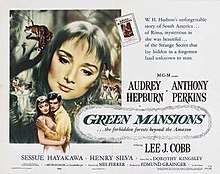| Green Mansions | |
|---|---|
 Theatrical release lobby card by Joseph Smith | |
| Directed by | Mel Ferrer |
| Screenplay by | Dorothy Kingsley |
| Based on | Green Mansions 1904 novel by William Henry Hudson |
| Produced by | Edmund Grainger |
| Starring | Audrey Hepburn Anthony Perkins |
| Cinematography | Joseph Ruttenberg |
| Edited by | Ferris Webster |
| Music by | Heitor Villa-Lobos Bronislau Kaper |
| Color process | Metrocolor |
Production company | Metro-Goldwyn-Mayer |
| Distributed by | Metro-Goldwyn-Mayer |
Release date |
|
Running time | 104 minutes |
| Country | United States |
| Language | English |
| Budget | $3,288,000[1] |
| Box office | $2,390,000[1][2] |
Green Mansions is a 1959 American adventure-romance film directed by Mel Ferrer. It is based upon the 1904 novel Green Mansions by William Henry Hudson. The film starred Audrey Hepburn (who at the time was married to Ferrer) as Rima, a jungle girl who falls in love with a Venezuelan traveller played by Anthony Perkins. Also appearing in the film were Lee J. Cobb, Sessue Hayakawa and Henry Silva. The score was by Heitor Villa-Lobos and Bronislau Kaper.
The film was intended to be the first of several projects directed by Ferrer and starring his wife, but ultimately this was the only one released. It was one of the few critical and box office failures of Hepburn's career. Vincente Minnelli had been slated to direct the film, but delays in the project led Metro-Goldwyn-Mayer to choose Ferrer to direct.
The film was the first feature film to be photographed using Panavision lenses for 35mm anamorphic widescreen cinematography; however, the process listed on the titles was CinemaScope, the 35mm anamorphic widescreen process developed in the early 1950s by 20th Century-Fox in conjunction with the U.S. optical company Bausch and Lomb. MGM resented having to both rent the special lenses and pay a royalty to Fox for use of the CinemaScope credit on its films, so it engaged Panavision, a then small Los Angeles-area manufacturer of anamorphic projection lenses for theaters, to develop anamorphic lenses for photographing MGM's widescreen productions. Given the popularity and public awareness of the CinemaScope brand, MGM entered in to an agreement with Fox to continue paying for the use of the CinemaScope title on its productions while actually using the new Panavision lenses and listing a small credit elsewhere in the titles, "Process Lenses by Panavision". Projected in the theater, the processes are identical in terms of the size of the film used and the screen width and height. By the late 1960s, Fox adopted Panavision for use on its 35mm anamorphic widescreen productions and withdrew the CinemaScope lenses from the market as Panavision had become the motion picture industry's standard due to its reputation for superior optical performance.
- ^ a b "The Eddie Mannix Ledger". Los Angeles: Margaret Herrick Library, Center for Motion Picture Study.
{{cite journal}}: Cite journal requires|journal=(help). - ^ Domestic take see "1959: Probable Domestic Take", Variety, 6 January 1960, p 34.